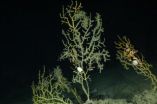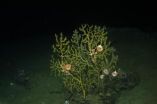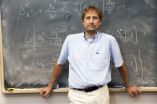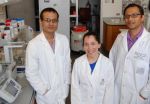(Press-News.org) A new discovery of two additional coral communities showing signs of damage from the Deepwater Horizon oil spill expands the impact footprint of the 2010 spill in the Gulf of Mexico. The discovery was made by a team led by Charles Fisher, professor of biology at Penn State University. A paper describing this work and additional impacts of human activity on corals in the Gulf of Mexico will be published during the last week of July 2014 in the online Early Edition of the journal Proceedings of the National Academy of Sciences.
"The footprint of the impact of the spill on coral communities is both deeper and wider than previous data indicated," said Fisher. "This study very clearly shows that multiple coral communities, up to 22 kilometers from the spill site and at depths over 1800 meters, were impacted by the spill."
The oil from the spill in the Gulf of Mexico has largely dissipated, so other clues now are needed to identify marine species impacted by the spill. Fisher's team used the current conditions at a coral community known to have been impacted by the spill in 2010 as a model "fingerprint" for gauging the spill's impact in newly discovered coral communities.
Unlike other species impacted by the spill whose remains quickly disappeared from the ocean floor, corals form a mineralized skeleton that can last for years after the organism has died. "One of the keys to coral's usefulness as an indicator species is that the coral skeleton retains evidence of the damage long after the oil that caused the damage is gone," said Fisher. The scientists compared the newly discovered coral communities with one they had discovered and studied around the time of the oil spill, using it as a model for the progression of damage caused by the spill over time. "We were able to identify evidence of damage from the spill in the two coral communities discovered in 2011 because we know exactly what our model coral colonies, impacted by the oil spill in 2010, looked like at the time we found the new communities."
Corals are sparse in the deep waters of the Gulf of Mexico, but because they act as an indicator species for tracking the impact of environmental disasters like the Deepwater Horizon blowout, the effort to find them pays off in useful scientific data. "We were looking for coral communities at depths of over 1000 meters that are often smaller than the size of a tennis court," said Fisher. "We needed high-resolution images of the coral colonies that are scattered across these communities and that range in size from a small houseplant to a small shrub."
To begin the search, the team used 3D seismic data from the Bureau of Ocean Energy Management to identify 488 potential coral habitats in a 40 km radius around the spill site. From that list they chose the 29 sites they judged most likely to contain corals impacted by the spill. The team then used towed camera systems and Sentry, an autonomous underwater vehicle (AUV), which they programmed to autonomously travel back-and-forth across specific areas collecting images of the sites from just meters above the ocean floor. Finally, the team used a Shilling ultra-heavy-duty remote-operated vehicle (ROV), to collect high-resolution images of corals at the sites where they were discovered.
"With the cameras on board the ROV we were able to collect beautiful, high-resolution images of the corals," said Fisher. "When we compared these images with our example of known oil damage, all the signs were present providing clear evidence in two of the newly discovered coral communities of the impact of the Deepwater Horizon oil spill."
In searching for coral communities impacted by the Deepwater Horizon oil spill, the team also found two coral sites entangled with commercial fishing line. These additional discoveries serve as a reminder that the Gulf is being impacted by a diversity of human activities.
INFORMATION:
In addition to Fisher, the research team included Pen-Yuan Hsing, Samantha P. Berlet, Miles G. Saunders and Elizabeth A. Larcom from Penn State; Carl L. Kaiser, Dana R. Yoerger, and Timothy M. Shank from the Woods Hole Oceanographic Institution; Harry H. Roberts from Louisiana State University; William W. Shedd from the Bureau of Ocean Energy Management; Erik E. Cordes from Temple University; and James M. Brooks from TDI-Brooks International Inc.
The research was supported by the Assessment and Restoration Division of the National Oceanic and Atmospheric Administration (NOAA), the Gulf of Mexico Research Initiative funding to support the Ecosystem Impacts of Oil and Gas Inputs to the Gulf (ECOGIG) consortium administered by the University of Mississippi, and B P as part of the Deepwater Horizon Oil Spill Natural Resource Damage Assessment.
CONTACTS
Charles Fisher: cfisher@psu.edu, 814-865-3365
Barbara Kennedy (PIO): science@psu.edu, 814-863-4682
IMAGES
High-resolution images are online at http://science.psu.edu/news-and-events/2014-news/Fisher7-2014
Impact of Deepwater Horizon oil spill on coral is deeper and broader than predicted
2014-07-28
ELSE PRESS RELEASES FROM THIS DATE:
The bit of your brain that signals how bad things could be
2014-07-28
An evolutionarily ancient and tiny part of the brain tracks expectations about nasty events, finds new UCL research.
The study, published in Proceedings of the National Academy of Sciences, demonstrates for the first time that the human habenula, half the size of a pea, tracks predictions about negative events, like painful electric shocks, suggesting a role in learning from bad experiences.
Brain scans from 23 healthy volunteers showed that the habenula activates in response to pictures associated with painful electric shocks, with the opposite occurring for pictures ...
Cell's recycling center implicated in division decisions
2014-07-28
Most cells do not divide unless there is enough oxygen present to support their offspring, but certain cancer cells and other cell types circumvent this rule. Researchers at The Johns Hopkins University have now identified a mechanism that overrides the cells' warning signals, enabling cancers to continue to divide even without a robust blood supply. In the process, the researchers found that lysosomes — the cell's protein "recycling centers" — help govern cell division decisions. They also uncovered new evidence that certain drugs can halt the growth of tumors that have ...
Facial features are the key to first impressions
2014-07-28
A new study by researchers in the Department of Psychology at the University of York shows that it is possible to accurately predict first impressions using measurements of physical features in everyday images of faces, such as those found on social media.
When we look at a picture of a face we rapidly form judgements about a person's character, for example whether they are friendly, trustworthy or competent. Even though it is not clear how accurate they are, these first impressions can influence our subsequent behaviour (for example, judgements of competence based on ...
Scripps Florida scientists find genetic mutations linked to salivary gland tumors
2014-07-28
JUPITER, FL - July 28, 2014 – Research conducted at the Florida campus of The Scripps Research Institute (TSRI) has discovered links between a set of genes known to promote tumor growth and mucoepidermoid carcinoma, an oral cancer that affects the salivary glands. The discovery could help physicians develop new treatments that target the cancer's underlying genetic causes.
The research, recently published online ahead of print by the Proceedings of the National Academy of Sciences, shows that a pair of proteins joined together by a genetic mutation—known as CRTC1/MAML2 ...
Glucose 'control switch' in the brain key to both types of diabetes
2014-07-28
Researchers at Yale School of Medicine have pinpointed a mechanism in part of the brain that is key to sensing glucose levels in the blood, linking it to both type 1 and type 2 diabetes. The findings are published in the July 28 issue of Proceedings of the National Academies of Sciences.
"We've discovered that the prolyl endopeptidase enzyme — located in a part of the hypothalamus known as the ventromedial nucleus — sets a series of steps in motion that control glucose levels in the blood," said lead author Sabrina Diano, professor in the Departments of Obstetrics, Gynecology ...
Physicists unlock nature of high-temperature superconductivity
2014-07-28
Physicists have identified the "quantum glue" that underlies a promising type of superconductivity -- a crucial step towards the creation of energy superhighways that conduct electricity without current loss.
The research, published online in the Proceedings of the National Academy of Sciences, is a collaboration between theoretical physicists led by Dirk Morr, professor of physics at the University of Illinois at Chicago, and experimentalists led by Seamus J.C. Davis of Cornell University and Brookhaven National Laboratory.
The earliest superconducting materials required ...
Google searches hold key to future market crashes
2014-07-28
A team of researchers from Warwick Business School and Boston University have developed a method to automatically identify topics that people search for on Google before subsequent stock market falls.
Applied to data between 2004 and 2012, the method shows that increases in searches for business and politics preceded falls in the stock market. The study, 'Quantifying the semantics of search behavior before stock market moves,' was published in the Proceedings of the National Academy of Sciences.
The researchers suggest that this method could be applied to help identify ...
Memory relies on astrocytes, the brain's lesser known cells
2014-07-28
VIDEO:
Salk scientists have discovered the link between astrocytes and memory.
Click here for more information.
LA JOLLA—When you're expecting something—like the meal you've ordered at a restaurant—or when something captures your interest, unique electrical rhythms sweep through your brain.
These waves are called gamma oscillations and they reflect a symphony of cells—both excitatory and inhibitory—playing together in an orchestrated way. Though their role has been debated, ...
Scientists discover genetic switch that can prevent peripheral vascular disease in mice
2014-07-28
Millions of people in the United States have a circulatory problem of the legs called peripheral vascular disease. It can be painful and may even require surgery in serious cases. This disease can lead to severe skeletal muscle wasting and, in turn, limb amputation.
At The University of Texas Health Science Center at Houston (UTHealth) Medical School, scientists tested a non-surgical preventative treatment in a mouse model of the disease and it was associated with increased blood circulation. Their proof-of-concept study appears in the journal Cell Reports.
Unlike ...
Mineral magic? Common mineral capable of making and breaking bonds
2014-07-28
TEMPE, Ariz. - Reactions among minerals and organic compounds in hydrothermal environments are critical components of the Earth's deep carbon cycle, they provide energy for the deep biosphere, and may have implications for the origins of life. However, very little is known about how minerals influence organic reactions. A team of researchers from Arizona State University have demonstrated how a common mineral acts as a catalysts for specific hydrothermal organic reactions – negating the need for toxic solvents or expensive reagents.
At the heart of organic chemistry, ...








